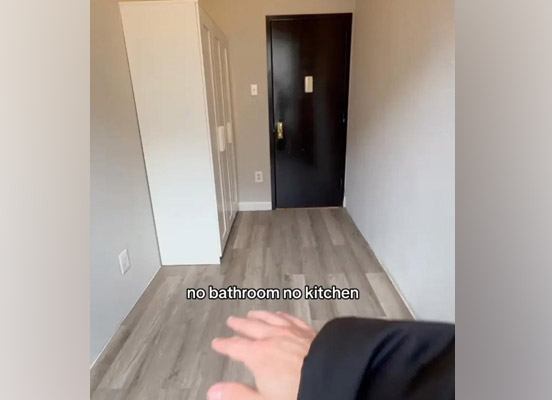
Wherever you live in the world, consider yourself lucky if you have a roof over your head, even if it has an occasional leak. Having a hole or two is quite normal these days, especially if you’re a renter.
Repairman: “Looks like something went through the roof.”
Tenant: “Yeah, I know. It’s my rent!”
Repairman: “Never seen a hole so big.”
Tenant: “You should see the one in my wallet.”
Yes, rents have been skyrocketing lately. How high are they? Well, in Manhattan, the smallest and most dense borough of New York City, you can rent a tiny apartment (115 square feet) for $1,200. Don’t get excited though. It doesn’t come with a bathroom or kitchen. You’ll have to rent them across the river in New Jersey. Don’t worry: it’s only a short train ride away. Just sit cross-legged, focus on your savings and you’ll be fine.
Actually, you don’t have to take a train to use a bathroom. You can share a hallway bathroom with the other tenants on your floor. Just take a number and wait patiently.
If you want an attached bathroom and kitchen, you’ll have to pay three times as much for a studio apartment. (That payment would get you a mansion in a small town like mine, but you wouldn’t get as much culture here, even if you make regular trips to the Indian store for their big tub of yogurt.)
NYC is the most expensive city for tenants in the world. To live comfortably in an NYC apartment building, you have to either have a high-paying job or be a rat.
Many other cities around the world have also seen rents soar beyond the means of people with average incomes. So how do ordinary folks manage? Many have roommates, sometimes squeezing enough people into an apartment to field a full squad for the weekend soccer league.
Referee: “Any substitutes today?”
Captain: “Not today. But we might have one next month — if my landlord increases the rent again.”
Living in a city like NYC, London or Mumbai is so expensive that many people choose to commute, traveling to the city by bus, train or even plane. At least a few people have revealed recently that they’re flying into a city weekly to save money. That’s what Wall Street Journal reporter Chip Cutter has been doing, taking a 6 a.m. flight from Columbus, Ohio, to NYC., staying in a hotel for a few days and flying home. If anyone wants to share an apartment with a WSJ reporter, let me know. He’s got pretty good soccer skills.
University of British Columbia student Tim Chen has also been commuting by plane. Rather than paying $2,500 in monthly rent, he’s taking twice-weekly flights to Vancouver from his parents’ home in Calgary. The round-trip flights cost him about $111, so he’s saving quite a bit, never mind that his carbon footprint would make Justin Trudeau blush.
Rents are increasing in small towns and cities too. That’s partly because landlords everywhere have higher costs, but it’s also because remote workers and others are able to pay more for rent. As my economics professor would say, it’s all about supply and demand. We have too much demand and too little supply. As a result, tenants are getting squeezed.
Repairman: “When your landlord sees my estimate, he may decide to turn that hole into a skylight.”
Tenant: “A skylight would be great. Then I’d get a good view of the sun, the clouds and my rent.”